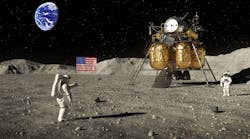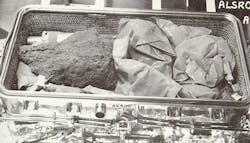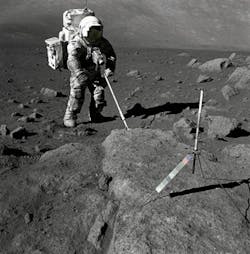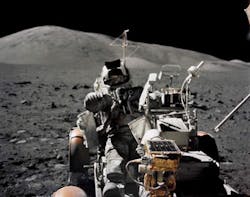Nearly 50 years ago, between 1971 and 1972, some lunar materials were brought back from the Moon to Earth by Apollo astronauts. Nine “special samples” were collected during the Apollo 15, 16, and 17 missions and stored in containers with indium knife-edge seals to maintain a lunar-like vacuum. Apollo mission planners devised these special sample containers to meticulously preserve fragile and transitory sample characteristics (e.g., solar wind volatiles and volatile coatings). Three of these samples have remained sealed in their original Apollo containers until today.
Cosmochemists at Lawrence Livermore National Laboratory will get a chance to analyze these Apollo 17 relics to study the geologic history of the site where the rocks were collected, a geologic cold trap where water may have been able to freeze. This marks the first time a sample will be studied in detail since the end of the Apollo program.
One of the Apollo 16 sample boxes is opened in the Lunar Receiving Laboratory on Earth. The box contains a large rock and many small sample bags. (Courtesy: NASA)
“Since the Apollo missions, science has advanced, so the importance of volatiles on the Moon has become more important. Furthermore, the advance in analytical tools over the past 50 years will let today’s investigators make measurements that were impossible during the Apollo missions,” says cosmochemist Lars Borg, who will head the LLNL team.
Volatile elements are trapped in the regolith of the lunar surface. Nearly the entire lunar surface is covered with regolith, and bedrock is only visible on the walls of steep craters. Regolith is fine rock powder created by meteorite bombardment of the Moon’s surface over the past 4.5 billion years.
Scientists estimate lunar regolith extends down 12 to 15 ft in some places, and as deep as 45 ft in the older highland areas. The mineral grains that make up the regolith have large surface areas, ideal for trapping volatile elements on the lunar surface.
Geologist-astronaut Harrison “Jack” Schmitt collects lunar rake samples during the first Apollo 17 extravehicular activity. Schmitt will be part of the LLNL team studying samples collected from the Apollo missions. (Courtesy: NASA)
A new NASA program, the Apollo Next Generation Sample Analysis, has selected nine teams to extend the science legacy of the Apollo missions by studying pieces of the Moon that have been carefully stored and remained untouched for nearly 50 years. LLNL is part of the University of New Mexico team of scientists that will look at the vacuum-sealed samples to study both the volatile element record and the geologic history of the Apollo 17 site.
The teams were selected by NASA’s Planetary Science Div. and will be funded by the space agency’s Lunar Discovery and Exploration Program. The goal is to get the most data possible from these samples in preparation for future lunar missions anticipated in the 2020s and beyond.
LLNL will conduct the measurement of noble gasses, as well as analyze major and trace elements and chronology on large clasts. Specifically, they will determine how noble gases were modified by meteorite impacts on the regolith, define the source of hydrogen in hydrogen-bearing minerals in the regolith, and investigate the origin of meteorites that hit the Moon through its history. The group will also determine the ages of samples in the regolith using a variety of dating techniques to better understand the timing of crust formation on the Moon.
Schmitt drove the Lunar Roving Vehicle approximately 22 miles while on the moon for the Apollo 17 mission. (Courtesy: NASA)
The samples won’t be opened right away. First, the teams will work with staff at NASA Johnson Space Center to determine the best way to open the samples to avoid contaminating them or destroying opportunities to learn something from them.
The LLNL team will help characterize samples and prepare a catalog so other lunar scientists can eventually request samples for specific analyses.
“These samples represent the first major suite of lunar samples to be analyzed since the end of the Apollo program, and are likely to significantly change the way we think about the Moon,” Borg said.




